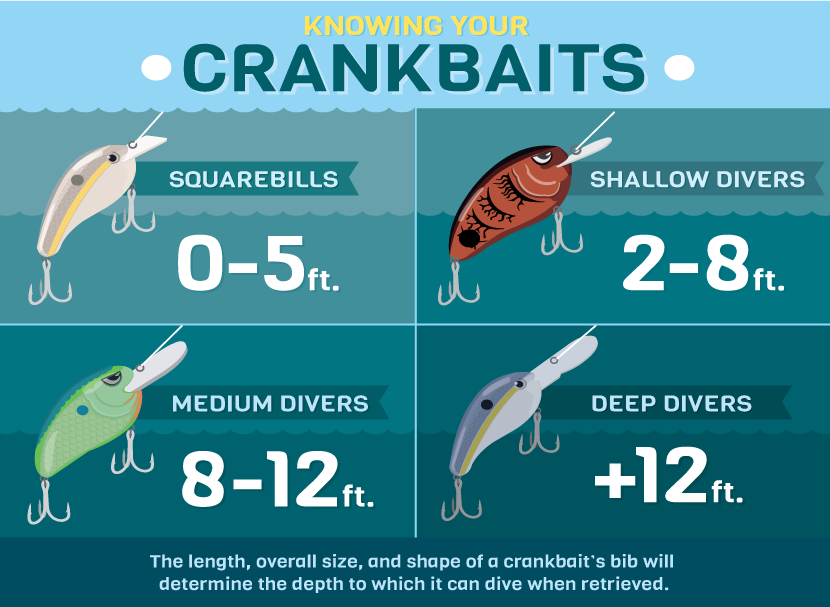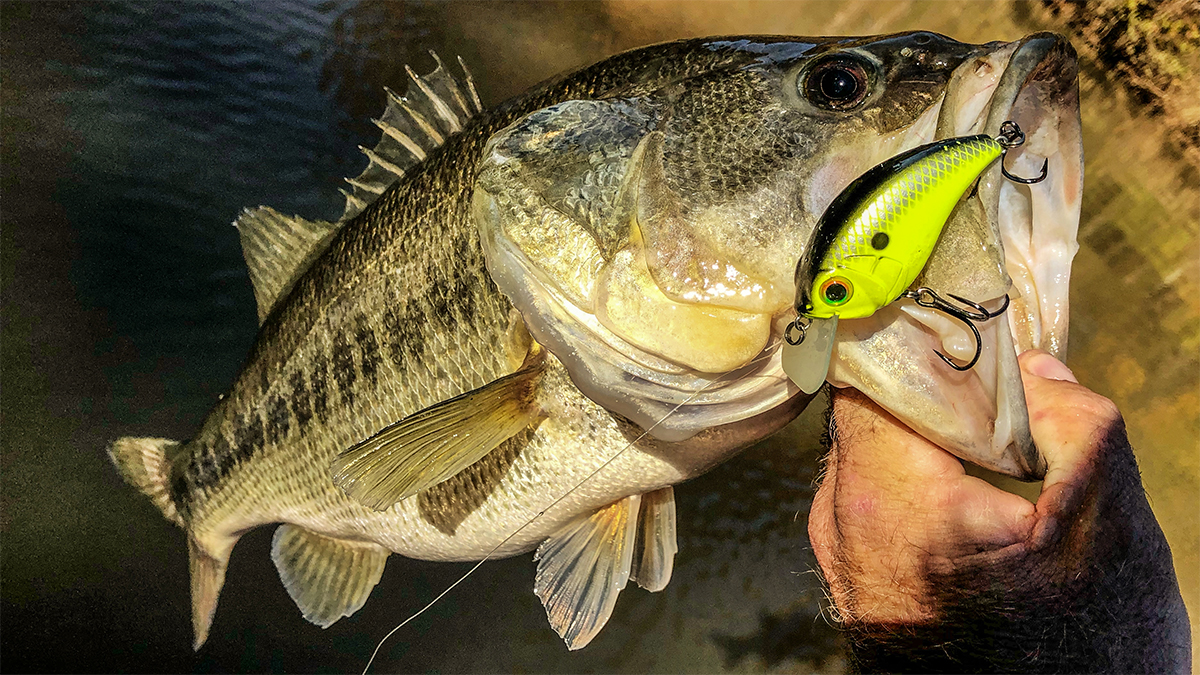Crankbaits are a popular lure choice for anglers who are fishing for a very wide range of species like Largemouth bass with differences in design to allow for optimum performance covering all specific depth ranges using a front lip or bill that controls shallow diving to medium depth, and deep-diving roles, depending on the season. How do you fish Crankbaits?
Lipless Crankbaits (no bill)-12 ft.+ depth-use slow retrieve in Spring & Fall
Lipped Crankbait (have a bill)-2 to 12 ft. use “twitching” motion-snap lure side to side in place with a slow retrieve
Square-shaped bill Crankbait-run along bottom-through grass & weeds shallow & close to the shoreline-0-5 ft.
Crankbaits are designed with diving lips that are round, or square affecting the action with various sizes and shapes. For example, wider lips will create a cool effect like a slower side-to-side wobble while narrow lips give a “tighter” action and have much faster-swimming action and erratic appearance.
What is a Crankbait

A Crankbait is a hard bait treble hook (2 treble hooks with 3 hooks on each treble hook) fishing lure usually made out of hard plastic or wood. Some contain BBs to create noise. Crankbaits are formed to mimic the real-life action of a baitfish, crayfish, or most other prey.
The bait’s flat hard sides create a very tight vibration and can kick up a lot of interest from a sleeping bass. There are 2 types of Crankbait Lipped or Lipless Crankbaits.
Lipped crankbaits (Billed) are typically hard-bodied lures with different-sized lips that allow the lure to dive to a number of different depths depending on the retrieve speed, size, and angle of the lip. When not being reeled in, a crankbait will float to the surface of the water.
The Square bill is designed to hit the bottom and is made to fish in shallow water and is very popular used for Largemouth Bass and is capable of fishing through weeds laid down trees and rocky bottoms.
Lipped Crankbaits- (Square Bill) Crankbaits can be retrieved over the top or around the edges of the grass. They can also be dragged through grass much more easily, which makes them great baits for enticing bass that are hiding in grass into aggressive reaction strikes.
The lipless crankbaits are generally sinking baits and unlike diving, crankbaits can be worked at any depth, although in shallow fishing applications, it may be challenging as you must have a fast retrieve speed to keep out of weeds or branches.
Lipless Crankbaits excel with smallmouth bass and relate to deeper water. Spring and Fall are the best times to fish a lipless crank. Its tight wobble makes it perfect for cooler water, and a lipless crank’s wheelhouse is between 45 and 60-degree water temperature.
When Should You Throw Crankbaits
Crankbaits are a great hard bait to use when an angler needs to cover a larger area of water faster at various depths making them a shallow medium or deep diving lure.
The key feature of a Crankbait is the size and shape of its front bill or it has a front bill like the Lipless Crankbait that is made for deeper water fishing. The prime times to throw these diving plugs are spring, summer, and fall in 5ft or less when fish come into shallow or deeper water calls for another type.
Crankbaits are dependable close to a mouth of a river in tidal water at low tide and at farther inside a lake or lagoon off the river at high tide. The banks off to the side should contain a lot of lay-downs with shade cover.

A square-shaped bill Crankbait will rip through grass and weeds shallow and close to the shoreline creating what’s called a “reactionary hit” triggering even the most lethargic of bass into coming to life.
The deflecting erratic lure imitates the same flash produced by a baitfish when it bumps into a log or down a tree and rolls on its side. The time of the year will dictate what type of Crankbait you may use the colors that will change inside the environment and the size of the Crankbait depending on where you are fishing all variables that change with seasons.
In Spring when the water temperature reaches the 52- to 55-degree range, try medium-diving crankbaits in crawfish patterns. After fish spawn in the spring, a shad color Crankbait works well.
In the Summer-Fish like bass lose interest in chasing fish because of rising temperatures and use something that will bring some noise and attention like a Square shaped Crankbait.
Fall is a prime time to throw shallow-diving square bill lures, medium divers, and deep-running crankbaits. In early fall throw, use deep-diving crankbaits for bass moving out of their summertime haunts to main and secondary points. It’s always good to select a model that looks like a natural baitfish, shad, or crawfish that’s on the menu.
How to Fish Crankbaits
The more erratic the Crankbait performs the more attention it demands especially good for bigger smallmouth you can cover deeper water using a lighter 10 to 12-pound test fluorocarbon line. In the shallows near trees fall or edges where you can’t normally access then it’s better to use a heavier-pound test line so ripping through weed and grass beds will be harder to fray it.
Use a start-and-stop retrieve technique and work by raising and lowering the tip of your rod helping the Crankbait dive and surface keeping more control of the height in the water column as you retrieve it. Raise the tip of your rod in shallower water ticking just above the grass covers or the lake bottom or lower it for deeper retrieves in the water column.
(Lipped) Square Billed Crankbait
- Fish shallow
- Crank your reel to get the desired depth
- Slow roll as you retrieve
- Stopping and starting to let the Crankbait fall is called (Twitching)
- Work the tip of your rod to raise and drop the tip for the desired depth
(Lippless) No Bill
- Fish deeper
- Lift your rod tip high and let the bait drop and sink hitting the bottom
- Repeat this technique called Yo-Yoing
*With a Medium-Lipped Crankbait, fish it is somewhat slower than the Square Bill and the (No Bill) Lipples bait. Use as little forward momentum as possible, and make the lure snap side to side in place to trigger a reluctant fish to strike.

Most experts believe that the only line to use with Crankbaits is the fluorocarbon line because it sinks allowing baits to run slightly deeper, it’s low in the stretch which adds to sensitivity and a better hookset but it’s resistant to abrasion improving durability.
Crankbaits also are more balanced and will fall with a slight wiggle until it hits the bottom. It actually looks like it’s swimming to the bottom as it falls. This time as it’s falling is the most likely time to get a strike, especially from a fish like a bass. Take advantage of this extra Crankbait movement by lifting your rod tip left then letting it fall then lift the bait right and let fall.
When you are fishing from a boat, try and keep the laydown from your cast at an angle and keep the Crankbait running perpendicular to the banks at the edge of the water. That way the crankbait spends more time moving sideways which will increase the odds of a strike.
Keep the Crankbait, especially when using a square bill as close to the market as possible scraping the bottom, retrieving slowly, and if you feel like you are getting stuck stop and let the bait float to the top.
Best Line for Crankbaits
The correct type of fishing line for crankbaits will be clear fluorocarbon between 12 and 15-pound tests, braid a not a good choice. Braided fishing line has little or no stretch and it is also highly visible.
The monofilament line stretches too much. When using lures such as crankbaits that have commonly two if not three large treble hooks then you need a little stretch in your line as you need to slow down your hook set a small bit.
Best Rod for Crankbaits
Because the Crankbait is a moving type of bait and is easy to lose fish on, a lot of times a fish will hit your lure and take off to another side. That will cause your rod to load up very quickly using too heavy a rod action won’t be able to set the treble hook and using too light a rod action will do the same so somewhere like a med to medium heavy will do the trick. A solution is for the rod to have some flex through the length.
Try keeping your rod length at around 6 ft 7″ to 7 2″ ft. Medium-heavy is the key ballpark is 7 feet in length. A fiberglass crank bait rod or a composite rod produced with a significant amount of flex can drastically increase your hooking percentage when fishing with crankbaits.
The glass involved with the fishing rod is conducive to casting for a bomb cast you can load up and throw the bait a mile or for a short chip shot cast around a target like a dock this type of rod can help you key in on a smaller area.
Best Reel for Crankbaits
Fishing with crankbaits is something that every serious angler will learn sooner or later. When you’re ready to fish crankbaits you’ll want to pick up the best crankbait reel along with a rod. Some characteristics that make up a crankbait reel might be a little different from standard thinking.
If you are fishing deeper water 20 -30 feet depth then you may want to gear your reel down Low gear ratio reel | 5.1:1 thru 5.4:1 will take the edge off that extra work better than higher ratio reels. A lower fishing gear ratio reel is ideal for big baits that pull a lot, such as deep crankbaits.
These reels have the highest amount of torque, allowing you to put less effort into retrieving the bait and more energy into finding the fish. It also allows for more incredible speed during the reentry of your next cast.
What is the Best Knot to Use when Tieing a Crankbait?
The best fishing knots to use tieing crankbaits are a standard Clinch knot along with a Non-Slip Loop Knot (Kreh Loop Knot) both knots are strong, easy to tie, & allow the crankbaits or any artificial lures to be tied directly to the lure allowing it more life-like action & presentation underwater.…………………………………………. Read more
JimGalloway Author/Editor


